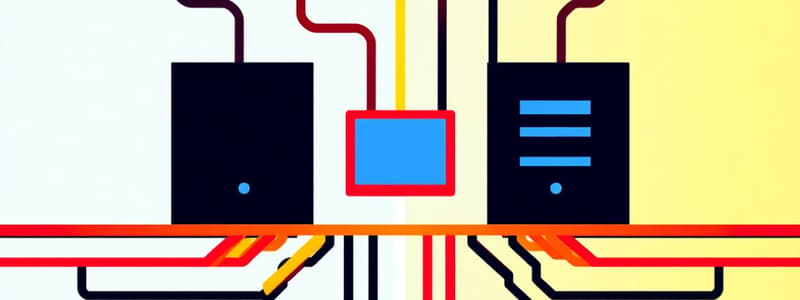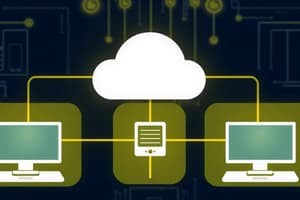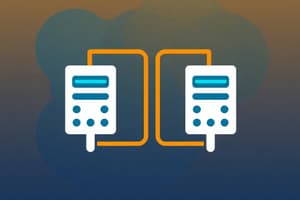Podcast
Questions and Answers
Layer 1 is the highest layer in network architecture.
Layer 1 is the highest layer in network architecture.
False (B)
A protocol governs the exchange of information between peer layers.
A protocol governs the exchange of information between peer layers.
True (A)
An interface facilitates communication between peer layers.
An interface facilitates communication between peer layers.
False (B)
Network architecture is a set of layers, protocols, and interfaces.
Network architecture is a set of layers, protocols, and interfaces.
Each layer in network architecture performs a single specific communication service.
Each layer in network architecture performs a single specific communication service.
Layer 5 protocol communicates directly with protocols from layers 1 to 4.
Layer 5 protocol communicates directly with protocols from layers 1 to 4.
The physical medium is part of layer 1.
The physical medium is part of layer 1.
The purpose of layers is to add complexity to the network and make it harder to troubleshoot.
The purpose of layers is to add complexity to the network and make it harder to troubleshoot.
In a client-server model, servers can store software.
In a client-server model, servers can store software.
Twitter is an example of e-commerce.
Twitter is an example of e-commerce.
Gnutella is a peer-to-peer network used for file sharing.
Gnutella is a peer-to-peer network used for file sharing.
Broadcast links involve a dedicated channel between two machines.
Broadcast links involve a dedicated channel between two machines.
Point-to-point links connect multiple machines using a single channel.
Point-to-point links connect multiple machines using a single channel.
A bus topology is an example of a point-to-point network.
A bus topology is an example of a point-to-point network.
In broadcast networks, messages sent by one machine are received by all others.
In broadcast networks, messages sent by one machine are received by all others.
Multicasting involves transmission from one machine to every machine on the network.
Multicasting involves transmission from one machine to every machine on the network.
Message M is generated by an application running in layer 5 of the source machine.
Message M is generated by an application running in layer 5 of the source machine.
Layer 4 adds a header that never contains message sequence information.
Layer 4 adds a header that never contains message sequence information.
Layer 3 breaks message M into smaller packets.
Layer 3 breaks message M into smaller packets.
Layer 2 adds a header to each packet, but this header will never contain packet sequence information.
Layer 2 adds a header to each packet, but this header will never contain packet sequence information.
The destination machine receives information in the same layer order as the source machine sends it.
The destination machine receives information in the same layer order as the source machine sends it.
The 20th and 21st centuries are heavily influenced by information technology.
The 20th and 21st centuries are heavily influenced by information technology.
Early computers were small and served only a few users.
Early computers were small and served only a few users.
Moore's Law states that the number of transistors on an integrated circuit doubles approximately every 18 months.
Moore's Law states that the number of transistors on an integrated circuit doubles approximately every 18 months.
Communication technologies only handle voice data.
Communication technologies only handle voice data.
Optical fibers are examples of high-speed communication links.
Optical fibers are examples of high-speed communication links.
Computer networks are a result of the separation of computers and communication technologies.
Computer networks are a result of the separation of computers and communication technologies.
In the past, organizations relied on many interconnected computers to serve their users.
In the past, organizations relied on many interconnected computers to serve their users.
A computer network is a collection of autonomous computers that are isolated from each other.
A computer network is a collection of autonomous computers that are isolated from each other.
The ARPANET was a small network consisting of 20 nodes in December 1969.
The ARPANET was a small network consisting of 20 nodes in December 1969.
MIT was one of the original four nodes on the ARPANET in 1969.
MIT was one of the original four nodes on the ARPANET in 1969.
The ARPANET's growth can be visualized through network diagrams at different time periods.
The ARPANET's growth can be visualized through network diagrams at different time periods.
By March 1971, the ARPANET included nodes such as Illinois, Lincoln, and Case.
By March 1971, the ARPANET included nodes such as Illinois, Lincoln, and Case.
Harvard and Burroughs were connected to the ARPANET by July 1970.
Harvard and Burroughs were connected to the ARPANET by July 1970.
SDC (System Development Corporation) was not part of the ARPANET in its early stages.
SDC (System Development Corporation) was not part of the ARPANET in its early stages.
The University of Alaska was one of the first four nodes on the ARPANET.
The University of Alaska was one of the first four nodes on the ARPANET.
By September 1972, the ARPANET included several nodes on the East Coast of the USA.
By September 1972, the ARPANET included several nodes on the East Coast of the USA.
The RAND Corporation was not connected to the ARPANET.
The RAND Corporation was not connected to the ARPANET.
UCLA, UCSB, SRI, and the University of Utah were among the institutions with a large amount of ARPA contracts.
UCLA, UCSB, SRI, and the University of Utah were among the institutions with a large amount of ARPA contracts.
The NSFNET was a successor to the ARPANET.
The NSFNET was a successor to the ARPANET.
To access the ARPANET, a university needed a research grant with the Department of Energy.
To access the ARPANET, a university needed a research grant with the Department of Energy.
The NSFNET connected users at universities, research labs, libraries, and museums.
The NSFNET connected users at universities, research labs, libraries, and museums.
CSNET was funded by NASA in 1981.
CSNET was funded by NASA in 1981.
The NSFNET only consisted of a backbone and no regional networks
The NSFNET only consisted of a backbone and no regional networks
The NSFNET was created before the ARPANET.
The NSFNET was created before the ARPANET.
In 1988, the NSFNET backbone connected NSF supercomputer centers and NSF midlevel networks.
In 1988, the NSFNET backbone connected NSF supercomputer centers and NSF midlevel networks.
Clients typically connect to their ISP via a fiber-optic cable.
Clients typically connect to their ISP via a fiber-optic cable.
Flashcards
Message M
Message M
Message generated by application layer.
Layer 4 function
Layer 4 function
Adds header, may contain sequence info.
Layer 3 function
Layer 3 function
Breaks message into smaller packets.
Packet
Packet
Signup and view all the flashcards
Layer 3 Header
Layer 3 Header
Signup and view all the flashcards
Dominant Technology (20th/21st centuries)
Dominant Technology (20th/21st centuries)
Signup and view all the flashcards
Computer Evolution
Computer Evolution
Signup and view all the flashcards
Moore's Law
Moore's Law
Signup and view all the flashcards
Communication Evolution
Communication Evolution
Signup and view all the flashcards
Modern Communication Links
Modern Communication Links
Signup and view all the flashcards
Computer Networks
Computer Networks
Signup and view all the flashcards
Client-Server Model
Client-Server Model
Signup and view all the flashcards
Computer Network (Technical Definition)
Computer Network (Technical Definition)
Signup and view all the flashcards
Business Applications of Networks
Business Applications of Networks
Signup and view all the flashcards
Home Applications
Home Applications
Signup and view all the flashcards
Peer-to-Peer (P2P)
Peer-to-Peer (P2P)
Signup and view all the flashcards
Broadcast Link
Broadcast Link
Signup and view all the flashcards
Point-to-Point Link
Point-to-Point Link
Signup and view all the flashcards
Network Topology
Network Topology
Signup and view all the flashcards
Broadcast Network
Broadcast Network
Signup and view all the flashcards
Multicasting
Multicasting
Signup and view all the flashcards
Layered Network Architecture
Layered Network Architecture
Signup and view all the flashcards
Network Protocol
Network Protocol
Signup and view all the flashcards
Network Interface
Network Interface
Signup and view all the flashcards
Network Architecture
Network Architecture
Signup and view all the flashcards
Layer 1: Physical Layer
Layer 1: Physical Layer
Signup and view all the flashcards
Layer 2: Data Link Layer
Layer 2: Data Link Layer
Signup and view all the flashcards
Layer 3: Network Layer
Layer 3: Network Layer
Signup and view all the flashcards
Layer 4 : Transport Layer
Layer 4 : Transport Layer
Signup and view all the flashcards
ARPANET original size
ARPANET original size
Signup and view all the flashcards
ARPANET's initial nodes
ARPANET's initial nodes
Signup and view all the flashcards
ARPANET's first operational date
ARPANET's first operational date
Signup and view all the flashcards
ARPANET's network growth
ARPANET's network growth
Signup and view all the flashcards
What is SRI
What is SRI
Signup and view all the flashcards
Network Topology Maps
Network Topology Maps
Signup and view all the flashcards
ARPA funding
ARPA funding
Signup and view all the flashcards
ARPANET Growth: Date
ARPANET Growth: Date
Signup and view all the flashcards
ARPANET Growth: Date
ARPANET Growth: Date
Signup and view all the flashcards
ARPANET Growth: Date
ARPANET Growth: Date
Signup and view all the flashcards
What does NSF stand for?
What does NSF stand for?
Signup and view all the flashcards
What was CSNET?
What was CSNET?
Signup and view all the flashcards
What was NSFNET?
What was NSFNET?
Signup and view all the flashcards
What is a Backbone?
What is a Backbone?
Signup and view all the flashcards
What is a Regional Network?
What is a Regional Network?
Signup and view all the flashcards
What are NSF Supercomputer Centers?
What are NSF Supercomputer Centers?
Signup and view all the flashcards
What is a Regional ISP?
What is a Regional ISP?
Signup and view all the flashcards
What does NAP stand for?
What does NAP stand for?
Signup and view all the flashcards
Study Notes
Introduction to Computer Communications and Networks
- The 20th and 21st centuries are defined by the technology of information gathering, processing, and distribution.
- There has been rapid technological progress in both computers and communications.
Evolution of Computers
- Computers were previously centralized and large, serving numerous users via mainframes.
- Computers are currently more powerful and smaller due to Moore's Law:
- The number of transistors on an integrated circuit (IC) doubles approximately every 18 months without increasing the cost per IC.
- Cost per transistor on an IC reduces by a factor of 2 every 18 months.
Communications Advancements
- Communications handle various forms of data including voice and video, transitioning from analog to digital formats.
- High-speed communication links exist through optical fibers.
- Wireless communications utilize modulation, detection, and estimation techniques.
Computer Networks
- Combining computer and communication technologies is what lead to computer networks
- Organizations have moved away from the old model of a single computer serving all users.
- The current structure is with numerous separate but interconnected computers doing the job.
- Computer networks is used to describe autonomous computers interconnected by a communication medium.
Applications of Computer Networks
- Business applications employ resource sharing for programs, databases, files, and printers accessible to network users,
- Servers store software such as programs, files, and records.
- Hardware like printers, scanners, and CD burners are connected, supporting the client-server model.
Home Applications of Computer Networks
- Home applications include e-mail, instant messaging (ex: Twitter), and streaming multimedia.
- Peer-to-peer communications are utilized for file sharing like Gnutella and BitTorrent.
- Social network applications (ex: Facebook) and e-commerce (online banking, online shopping) have become prominent.
Network Hardware - Transmission Technology
- Broadcast links: a single communication channel shared among multiple machines.
- Point-to-point links: a dedicated communication channel connecting only two machines.
- Network classification is thus based on network topology (structure).
Network Classification based on Topology
- Broadcast networks share a single communication channel among all machines on the network.
- Topologies include:
- bus
- ring
- Topologies include:
- Any machine sends messages that are received by all.
- Some broadcast systems support transmission from one machine to a subset of others, known as multicasting.
Point-to-Point Networks
- Point-to-point networks consist of links connecting individual pairs of machines.
- Connection to every machine is not required.
- Messages may visit intermediate machines to reach their destination.
- Topologies include:
- star
- mesh
- fully connected
- Topologies include:
Local Area Networks (LAN)
- Local Area Networks (LAN) cover a localized area, office building, university campus, up to a few kilometers.
- Typically (but not always), LANs use broadcast topologies.
- A core challenge in LANs is handling multiple access to avoid conflicts in transmission
- Static channel allocation entails dividing time into slots, using a round-robin approach for each machine to transmit in its slot (TDMA).
- This can be capacity-inefficient, where a machine has nothing to send during its allocated slot.
- Dynamic channel allocation can be centralized (a central controller that decides who transmits next) or decentralized.
LAN Examples
- Classic Ethernet was developed by Xerox researcher Bob Metcalfe in 1976, and has a bus topology.
- Wireless LAN uses IEEE 802.11.
- Switched Ethernet is also used, which is a wired LAN built from point-to-point links.
- Wireless LANs have a broadcast topology.
Metropolitan Area Networks (MAN)
- Metropolitan Area Networks (MAN) covers a city (10's of kilometers across)s
- A common example is cable TV networks available in many cities.
Wide Area Networks (WAN)
- Wide Area Networks (WAN) cover a country or continent at 100's or 1000's of kilometers across.
- One example is the WAN that connects hosts in Perth, Melbourne, and Brisbane, Australia.
WAN Components
- Hosts: network users running application problems.
- Subnet: responsible for host-to-host message delivery.
- Switching elements: specialized computers for the subnet (routers are now commonly used).
- Transmission lines/links: move information between machines.
Internetworks
- Many networks exist using different hardware and software.
- Users on one network may want to communicate with users on a different network.
- Using gateways, different networks enable connecting possibly incompatible networks..
- A collection of interconnected networks is known as an internetwork (example: the Internet).
Switching Methods
-
Circuit Switching (originally designed for the telephone networks) establishes a dedicated, continuous path for the duration of a communication session like a phone call.
-
Packet Switching involves dividing communication "messages"into smaller units called packets.
- Packets transmit individually through possibly different routes in the network without dedicated paths.
- Switching elements store arriving packets then forwarding them to a certain route.
- Subnets using packet switching are called store-and-forward subnets.
- Packets belonging to the same session may take different paths.
-
Message Switching - same as packet switching but communication units or data packets are larger: messages
Network Architecture
- Network functionality is organized as a stack of layers.
- Each layer carries out a communication service from the higher layer to the next.
- Protocol is a set of rules that govern the information exchange between peer layers.
- A protocol consists of several layers (i.e., layer n on one machine to layer n on another machine)
- Interface facilitates communication between successive layers on the same machine.
- A set of layers, protocols, and interfaces is known as a network architecture.
Layer Communications
- A message M is created by an application running in layer 5 of the source machine
- M is given to layer 4 for transmission.
- Layer 4 adds a header (message sequence information) and passes the message to layer 3.
- Layer 3 breaks message M into small packets, and adds a layer 3 header (to determine the packet sequence) to each packet.
- Layer 3 decides the outgoing link for each packet and passes the packets to layer 2.
- Layer 2 adds a header and trailer to each packet and delivers the resulting unit to layer 1 for physical transmission.
- At the receiving machine, the message forwards upwards from layer to layer with headers and trailers stripped off.
Connection Vs Connectionless Services
- Networks layers provide two types of service: connection-oriented and connectionless.
- Connection-oriented service
- A service user establishes a connection, uses a connection, then releases the connection.
- Negotiation between sender and receiver may be required before the connection.
- Messages and packets usually arrive in order.
- Connectionless Service
- Each message and packet carries full destination address information and is routed through the network independently.
- Messages and packets arrive out of order.
The OSI Reference Model
- The Open Systems Interconnections (OSI) model was developed by the International Standards Organization (ISO)
Physical Layer
- Transmits raw bits over a communication channel.
- Design issues: Transmitted 1 is received as intended and not as a 0.
Data Link Layer
- Transforms an unreliable raw bit pipe into a communication channel for transmitting frames error free reliably.
- Performs error detection and error correction.
- Performs flow control to stop a fast transmitter from overwhelming a slow receiver.
- In broadcast networks, handles multiple accesses with a special sub-layer which is called the medium access control (MAC).
Network Layer
- Provides routing to provide a virtual channel for end-to-end packets via static or dynamic routing.
- Utilizes Congestion control to avoid link bottle necks.
- Broadcast network routing is simple or non-existent making the network layer is often thin or non-existing.
Transport Layer
- Breaks larger "messages" into smaller packets at Transmit side, and assembles packets into larger "messages" at the Receive side.
- Corrects out of order delivery and lost packets.
- Performs end-to-end flow and congestion control and may perform end-to-end error control.
Session Layer
- Allows users from different machines to establish sessions between them.
Presentation Layer
- Works with the syntax and semantics of the information transmitted.
- Performs:
- Encryption
- Data compression
- File format transfer
- Performs:
Application Layer
- Consists of any application program of the end user.
The TCP/IP Reference Model
- Used in the grandparent of all computer networks, the ARPANET (Advanced Research Projects Agency) & it successor the Internet.
The Internet Layer
- Is connection-less, enabling hosts to inject packets into the network and routed independently to the destination - may arrive out of order.
- Defines the packet format in a protocol called the Internet Protocol (IP).
- The internet layer is very similar to the network layer in the OSI model.
The Transport Layer
- Allows source and destination hosts to carry on a conversation similar to the OSI transport layer and is an end-to-end layer
- It provides two end-to-end protocols
- TCP (Transport Control Protocol): This is a reliable connection-oriented protocol comprised of a byte stream into discrete messages and handles flow and congestion control.
- UDP (User Datagram Protocol): An unreliable, connectionless protocol for applications with prompt over accurate delivery where TCP's flow control is unneeded, ex: voice and video.
The Application Layer
- Contains all the higher-level protocols
- File transfer (FTP)
- E-mail (SMTP, Simple Mail Transfer Protocol)
- Domain Name System (DNS) for mapping host names onto their network addresses
- HTTP (the protocol for creating pages on the World Wide Web)
The Link Layer
- Describes what links such as serial lines and Ethernet must do to meet the needs of the connectionless Internet layer.
- It is not really a layer at all, in the normal sense of the term, but rather an interface between hosts and transmission links (allows hosts to inject packets into the network).
Example Network: ARPANET
- In the 1950's US military communications used the general telephone network.
- The US Department of Defence wanted a network that could survive failures.
- ARPA (Advanced Research Projects Agency) was created to solve the issue.
Original ARPANET Design
- Subnet made up of IMP’s (Interface Message Processors)
- IMP's are connected by 56 Kbps transmission lines (leased lines from telephone companies).
- Every IMP connected to at least 2 other IMP’s (for reliability)
Growth of ARPANET
- In its early stages had universities such as:
- UCLA
- UCSB
- SRI (Stanford Research Institute)
- The University of Utah who had a considerable amount of ARPA contracts.
NSFNET
- In the 1970's, NSF i(US National Science Foundation) recognized impact the ARPANET was making regarding university research.
- Access to ARPANET required universities to have a research contract with the Department of Defense.
- NSF’s initial response was to fund the Computer Science Network (CSNET) in 1981.
- Connected Computer Science departments and industrial research labs to ARPANET.
- During 1980s, NSF decided to design a successor to ARPANET: the NSFNET comprised a backbone and various regional networks.
- It enabled users at thousands of universities, research labs, libraries and museums to be connected.
Current Internet Configuration
- Clients at home call their ISP over a dial-up telephone line.
- The modem card within the PC converts the digital signals (produced by the PC) into signals for telephone system.
- Signals transfer to the ISP's Point of Presence (POP), removed from the telephone system, and injected into the ISP's regional network.
- The ISP's Network routes include interconnected routers in cities the ISP serves.
- The packet travels on a dedicated host, otherwise, the packet forwards to the ISP’s backbone operator.
- Backbone operators operates large international backbone networks with thousands of routers connected by optical fibers.
- The differences of interconnected backbones happen within Network Access Points (NAPs).
- In NAPs the router forwards from backbone to backbone using a LAN.
Studying That Suits You
Use AI to generate personalized quizzes and flashcards to suit your learning preferences.




